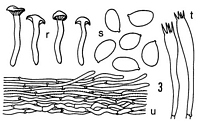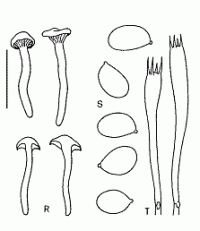|
 Camarophyllus canus Camarophyllus canus
SynonymsHygrocybe cana
BiostatusPresent in region - Indigenous. Endemic
Images (click to enlarge)
Caption: Fig. 3: Camarophyllus canus Hk. (type): r. carpophores. - s. spores. - t. basidia. - u. cuticl | 
Caption: Fig. 21 Camarophyllus canus Horak (R-T: PDD 27072, type): R.
basidiomes. S. spores. T. basidia. |
Article: Horak, E. (1990). Monograph of the New Zealand Hygrophoraceae (Agaricales). New Zealand Journal of Botany 28(3): 255-306 (http://www.rsnz.org/publish/abstracts.php).
Description: Pileus -10 mm, hemispherical to convex becoming plano-convex, non-striate margin
always inrolled, slate grey with faint lilac tinge; dry, minutely fibrillose,
hygrophanous. - lamellae arcuate to decurrent rather distant, concolorous with
pileus edges entire. - stipe 15-30 x 2-3 mm, cylindrical, equal, rather stout;
whitish to pale grey; dry, 1ongitudinally fibrillose, stuffed, single or caespitose.
- Context pale grey, not waxy. - Odour and taste not distinctive. - Chemical
reactions on pileus: KOH, HCI and NH3 - negative.
Spores 5.5-7 x 4-4.5 um, ovoid. - Basidia 42-50 x 6-7 um, 4-spored –Cystidia
absent- Pileipellis a cutis of interwoven, cylindrical hyphae (2-6 um diam.),
membrane not gelatinised, minutely encrusted with pigment, clamp connections
present (Pl. 1, Fig. 5).
Habitat: ECOLOGY: Rare; saprobic on soil among litter of Leptospermum-Nothofagus.
March.
Distribution: DISTRIBUTION: NZ (SL).
Article: Horak, E. (1973). Fungi Agaricini Novazelandiae I-V. Beihefte zur Nova Hedwigia 43: 200 p.
Description: Pileus 5-10 mm diam., hemispherical when young becoming plano-convex, estriate margin always inrolled, slate grey with faint lilac tinge, dry, hygrophanous, minutely fibrillose. Lamellae arcuate to decurrent, concolorous with pileus, distant, gill edge concolorous, even. Stipe 15-30 x 2-3 mm cylindric, equal, whitish or greyish, dry, longitudinally fibrillose, stuffed, mostly single. Context greyish. Taste and odor not distinctive. Chemical reactions on Pileus: KOH, HCl and NH3 - negative.
Spores 5.5-7 x 4-4.5 µm, ovoid, smooth, inamyloid. Basidia 42-50 x 7 µm, 4-spored. Cystidia absent. Gill trama interwoven. Cuticle a cutis consisting of repent, irregularly arranged, cylindric, not gelatinized hyphae (2-6 µm diam.). Clamp connections present.
Habitat: On soil amongst mosses under Leptospermum scoparium (and Nothofagus cliffortioides). New Zealand.
Notes: The grey to lilac or violaceous drab colour of C. canus Hk. reminds of H. subviolaceus Peck (see Hesler & Smith 1963: 62) but its dry cuticle, the smaller size of the carpophores and its habitat distinctly separate these two fungi.
|